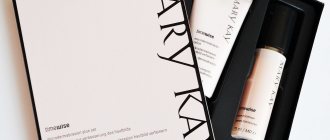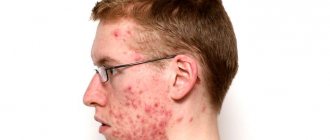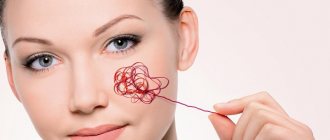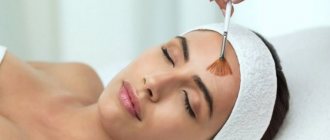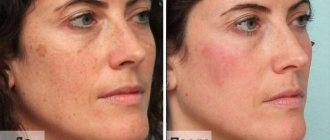The widespread use of chemical peeling in recent years is explained by the relative safety and simplicity of the procedure, and most importantly, its effectiveness. Deep peeling has become especially popular, radically changing the appearance of the skin. This method of rejuvenation and elimination of aesthetic defects is comparable in results to plastic surgery. But how harmless this operation is, what risks may arise when performing it, and whether it can be done at home, we will tell you in this article.
What is deep peeling?
Deep chemical peeling is practically a plastic surgery, as it is performed under anesthesia. The main component in the procedure is phenol, an extremely toxic organic compound that, if used incorrectly, can become a real murder weapon. The entry of carbolic acid into the blood can cause serious problems with the liver and kidneys, and sometimes even death.
However, do not be alarmed; you need to know this in order to be careful when choosing clinics and specialists who perform chemical peeling. You should not do the procedure at home; it is better to trust the professionals.
Deep peeling is a complex, painful procedure that requires subsequent rehabilitation for up to six months.
Numerous age-related changes occurring in the epidermis, as a rule, occur after the age of 40 years. This is one of the most common reasons to do a deep chemical peel. The procedure allows you to eliminate freckles, moles, eliminates hyperpigmentation, benign neoplasms, as well as subcutaneous formations.
With the help of peeling, you can remove scars, traces of acne and vaccinations, shallow wrinkles, and stimulate the production of elastin and collagen in the skin. According to experts, the duration of the effect of the operation is 7-10 years.
Complications
The most common complications of chemical facial peels are the increase or appearance of areas of hyperpigmentation, persistent erythema, or a noticeable line of demarcation. Home use of creams with glycolic acid significantly prolongs the effectiveness of peeling.
If the technology for chemical facial peeling using trichloroacetic and carbolic acid is not followed, serious skin burns may develop. From the point of view of complications, the most dangerous is phenol peeling, due to the toxic effect of carbolic acid on the heart and kidneys.
Features of superficial chemical peeling
For example, almond peeling is one of the types of chemical surface peeling, the basis for which is fruit acids.
Almond peeling is a superficial chemical peel. It affects the upper stratum corneum of the skin before reaching the vitreous layer. The composition of almond peeling mainly includes mandelic acid, 2-hydroxy-2-phenylacetic acid or phenylglycolic acid, which belongs to alpha hydroxy acids (they are often called fruit acids), obtained by hydrolysis from bitter almond extract.
It should be noted that it is not advisable to do almond peeling at home. First of all, a cosmetologist must determine the indications for such procedures and carefully monitor the process.
The peeling procedure itself includes several mandatory steps, on which the final result depends. First, the face is cleansed with milk containing 10% mandelic acid. Then a special composition of acids is applied to the skin, which helps determine the presence of allergic reactions in a person. After this, the peeling itself, which contains at least 30% of the active substance, is applied with massaging movements.
After 10 minutes, the product should be thoroughly rinsed with water. A soothing mask and moisturizer complete the process. After the procedure, the skin should be intensively moisturized for about a week, and before going outside, use sunscreen. The course can last from 6 to 10 procedures, the interval between them should be no more than 10 days, but the effect will be noticeable after the first sessions.
During the post-peeling period, in order to avoid discomfort and prolong the effect, it is necessary to use various auxiliary products that the cosmetologist will recommend.
These can be soothing masks, moisturizing and nourishing creams for home care.
It should be noted that almond peeling can cause some complications that can be easily eliminated with the right approach:
- Dryness and burning sensation that goes away after applying a moisturizer.
- Redness is eliminated with moisturizers.
- The skin may peel, which can be corrected with almond cream.
- More serious complications, which very rarely occur after such procedures, can be eliminated by a cosmetologist. Swelling of the skin, for example, is eliminated with hormonal ointments. Indications for the use of certain drugs must be agreed with a specialist.
Almond peeling deservedly justifies its growing popularity every day. There are many reviews about its successful use in cosmetology. After peeling, the skin becomes noticeably fresher and cleaner, feeling soft and smooth. The complexion improves, the pores narrow and the skin tone increases.
In addition, almond peeling can be used not only on the face, but also on the skin of the hands and décolleté. This is one of the most effective methods of combating age-related changes in the skin, activating its renewal. It has been proven that mandelic acid stimulates the synthesis of its own collagen and improves skin structure, which is why it has such a beneficial effect on mature skin.
Recovery period
The recovery period lasts several weeks. At this time, the skin will peel off and mild itching may occur. The center’s specialists will definitely recommend suitable products, including those containing panthenol, to minimize the signs of the rehabilitation period.
During the first days, it is not recommended to wash your face with water, and it is forbidden to use cosmetics. The ban on traumatic procedures, including home peelings and the use of scrubs, is valid for several months. It is necessary to go outside after applying sunscreen cosmetics.
Since skin trauma occurs during the procedure, it is necessary to carry out the session with special care, using high-quality antiseptics. Be careful when choosing a specialist or a suitable clinic. The center's employees take their work extremely seriously, avoiding negligence and inattention.
How is deep facial peeling performed?
The phenol peeling procedure is preceded by a therapeutic course necessary to prevent the development of herpetic and antibacterial infections. The pain of the operation requires the mandatory use of general painkillers. Typically, a 2% lidocaine solution is used as an anesthetic. Particular attention should be paid to calculating the dose of the drug, since it increases the level of toxicity of phenol and is neutralized by liver enzymes.
Preparing your face for peeling involves carefully removing dead skin cells with soap. Then the dried skin is additionally treated with acetone and alcohol for degreasing purposes.
Carrying out phenol peeling must be coordinated with a cosmetologist, who determines the individual characteristics of the skin and its condition at the time of the procedure.
Phenol peeling is applied to the face zonally, taking into account the structure of different areas of the skin. This is followed by covering the treated leather with a special film, onto which, after drying, geloleo is applied, a preparation resembling wax. It contains "hidden" phenol.
By reacting with the film, geleo “releases” phenol and acts on those areas of the skin where the activity of the first layer is insufficient. In this way, the process of self-regulation of depth by phenol peeling is launched. This complex mask remains on the face for 48 hours. It is almost impossible to make such a mask on your own at home.
Progress of the procedure
The procedure should be performed only by certified specialists in a hospital in the presence of an anesthesiologist and resuscitator under the control of a cardiac monitor.
Stages:
- Cleanses the surface of the face from dirt and excess oil. The epidermis is cleaned with soap, applied with a rough sponge and rubbed thoroughly. After this, the skin is dried and degreased with alcohol.
- The application of special substances containing phenol is performed after local or general anesthesia. It is necessary to distribute the substance as evenly as possible on the skin. The solution should be applied slowly with short breaks of 10-15 minutes.
- Silicone is applied on top of the phenol solution, forming a film on the face, on top of which another substance is applied - jelly. This entire mask, depending on the expected effect, stays on the face for 1-3 days. After this period has expired, the mask is removed and a wound healing cream is applied to the skin.
The procedure itself takes up to 3 hours. The effect of the procedure is visible only 7-10 days after completion. The overall effect lasts for 6-8 years.
Deep chemical peels are recommended to be performed once; repeated use throughout life may increase the risk of complications. If necessary, it is possible to use superficial and medium peels, which are safer.
Before and after photo No. 1
Before and after photo No. 2
Before and after photo No. 3
Rehabilitation period
The presence of a phenol mask on the face is marked by severe pain, which requires the administration of certain painkillers. In addition to a burning sensation and tingling sensation on the skin, the movement of the facial muscles is limited as much as possible. During the first 72 hours, contact of the patient’s face with water is unacceptable: you can drink only with a straw, and brush your teeth without rinsing your mouth.
After two days, the cosmetologist carefully removes the phenol mask with a plastic spatula. The softened layer of epithelium also comes off with it. A bright red surface covered with wounds is formed. After 24 hours, fibrin is applied to the bleeding area, causing the skin to turn greenish. At this stage, the cosmetologist allows patients to wash themselves with water.
On the 10th day, fibrin films peel off, revealing fresh, young, pink skin. After three weeks, the renewed skin can already be powdered, although redness remains for two months, and its full maturation will take about six months.
Kinds
In cosmetology, there are numerous variations of facial peels. They differ not only in the active ingredients, but also in the technologies used. In this section we will introduce you to hardware and acid types. Let's tell you how they are effective and what they are used for.
Hardware
The effect of hardware peeling is achieved by exposing skin cells to a laser or radio wave, causing them to evaporate (ablation). In this case, heat does not penetrate into neighboring tissues, which eliminates the occurrence of scars and other complications after the procedure.
- An anesthetic solution is injected into the skin area and thoroughly moistened with saline solution.
- After which the doctor treats the skin with a laser or radio wave.
- The procedure lasts about an hour, upon completion the face is treated with Vaseline or emollient cream.
We recommend: Types of anti-aging exfoliants: what is more effective for the skin - yellow peeling or TCA?
A day after the procedure, swelling appears, which disappears on the sixth or seventh day. During healing, the skin is treated with a softening cream. On the fourth day, a scab appears from the procedure, which disappears on the 10th day. If postoperative erythema occurs, the skin is treated until it disappears. To do this, use creams with a high degree of ultraviolet protection.
Acid
For acid peeling, one or more acids are used. Acid affects the skin at the molecular, cellular and tissue level. Has exfoliating, regenerating and antioxidant effects. The acid destroys the intercellular connections between the cells of the stratum corneum, which leads to the synthesis of collagen and elastin. Acids that may be included in deep peeling:
- milk – having a keratolytic effect, moisturizes the skin;
- almond – the large size of its molecules reduces photosensitivity and whitens the skin;
- retinoic – enhances the synthesis of immune cells and improves tissue hydration;
- glycolic – used in the self-rejuvenation method and as a preparatory stage for serious procedures;
- salicylic acid – used in the treatment of acne.
Acid peeling normalizes the functioning of the sebaceous glands, activates the protective properties of the skin and promotes regeneration.
Risks of Chemical Peels
When in contact with the skin, phenol, used in deep peeling, interacts with plasma protein and damages blood vessels. Thus, the substance entering the blood can provoke arrhythmia.
The concentration of phenol in the patient’s blood is influenced by the following factors:
- percentage of the substance in the peeling mass;
- work area size;
- speed of application of the composition to the skin;
- time of penetration of phenol into the body through the skin;
- the rate of breakdown of a substance in the body.
The behavior of phenol in the human body is comparable to a nephrotoxic poison that poisons the kidneys. The substance can cause death in large doses, but the amount in preparations intended for deep peeling is very small. In the liver, phenol is converted into a life-safe compound and then excreted by the kidneys.
Deep chemical peeling is practically plastic surgery, since this procedure is performed under general anesthesia.
It follows that for diseases of the kidneys, liver, or heart, chemical peeling is contraindicated. Deep facial peeling with phenol is strictly prohibited for pregnant women, people with cancer and chronic skin diseases (eczema, psoriasis, acne).
Indications and contraindications
Chemical peeling is recommended:
- patients with skin defects (pigmentation, sagging skin, wrinkles);
- clients with pronounced pigmentation;
- to eliminate scars and stretch marks;
- in the treatment of the inflammatory process.
Facial peeling is strictly not recommended:
- patients with allergies to the components of the product;
- damage to the skin;
- herpes;
- patients whose skin is prone to scarring;
- neoplasms;
- heart diseases;
- renal and liver failure.
Peeling in the salon does not require any special preparation from the patient.
Side effects of the procedure
In addition to the positive benefits, deep chemical peeling has a number of possible side effects:
- increased signs of allergies (in allergy sufferers);
- exacerbation of the herpes virus;
- the appearance of a third degree burn on the skin of the face, which will require protection from sunlight throughout life;
- kidney dysfunction;
- the occurrence of arrhythmia;
- loss of the skin's ability to produce pigment;
- susceptibility to the development of infectious diseases.
If you still decide to look 10 years younger, are not afraid of a long and difficult recovery period and have the opportunity to be minimally exposed to sunlight, then go for it. But remember, the success of the procedure and its safety can only be ensured by an experienced dermatocosmetologist and strict adherence to all his recommendations. Well, if deep peeling seems like a risky idea to you, you can always choose a safer and more affordable rejuvenation procedure.
Peeling course
The number of procedures differs depending on the type of substance.
- Superficial peelings are carried out once every 7-14 days in the amount of 5-10 procedures. Maintenance sessions are carried out 1-2 times a year.
- Medium peelings are used once every 15-30 days in the amount of 1-5 procedures. Maintenance course - once every 3-5 years. The optimal period is from November to March to avoid negative solar effects.
- Deep peelings - exposure is carried out rarely, 1-2 times during life when clear indications are identified.


